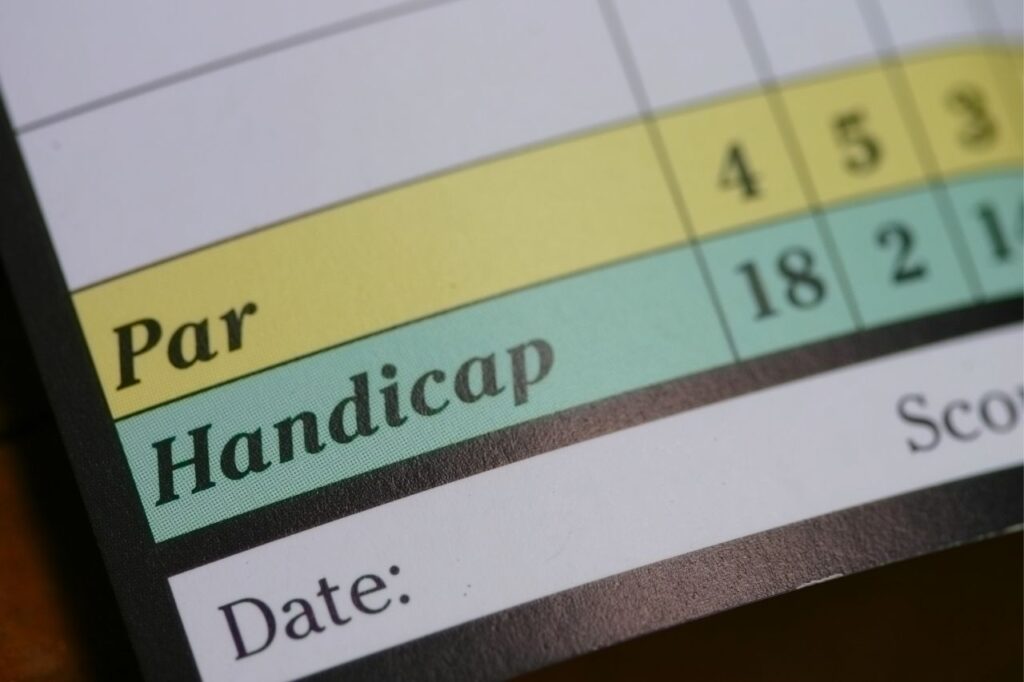

Are you ready to advance your golf game and compete on a level playing field with players of various abilities? Understanding how to compute your golf handicap, a valuable tool that levels the playing field and helps you to track your improvement over time is the key.
Whether you’re an experienced golfer or just getting started, learning to determine your handicap can improve your competition experience and give vital insights into your prospective playing abilities.
So, let’s go into the realm of handicaps and learn how to maximize your golfing ability.
What is a Golf Handicap?
A golf handicap is a calculation of a golfer’s skill level. Its purpose is to level the playing field and ensure fair competition among golfers of varying ability levels.
The handicap system provides that players compete on an equal footing by altering the number of strokes each player receives based on their handicaps.
Calculate your golf handicap by understanding scoring terms and their role in handicaps.
Handicap Index
- The Handicap Index is a numerical ranking indicating a golfer’s skill level regarding the courses’ difficulty.
- A lower Handicap Index indicates a better golfer, whereas a more considerable handicap indicates a worse player.
- It is determined by a golfer’s previous scores as well as the difficulty of the courses.
Course Handicap
- The number of strokes required to play to par from a particular set of tees on a course is represented by the Course Handicap.
- The Handicap Index, Course Rating TM, and Slope Rating® of the player are all used in the calculation.
- Course Handicap is adjusted based on the difficulty of the golf course.
- A course with a higher Course Rating TM and Slope Rating® are more complex.
Average Handicap Index
The average golf handicap varies based on the group or community under consideration.
However, according to USGA data, the average Handicap Index for men golfers is approximately 15.0, whereas it is around 27.0 for female players.
These averages are based on golfers regularly maintaining a Handicap Index and may not represent the global community of golfers.
How to Calculate Golf Handicap?




To calculate a golf handicap, follow the standards set out by the United States Golf Association (USGA) Handicap System.
The handicap system is designed to determine a golfer’s potential ability about par, allowing players of all skill levels to compete fairly. Here’s a high-level description of how to calculate a golf handicap:
- Gather Your Recent Golf Scores: Begin by gathering at least five scorecards from your most recent rounds of golf. These results will form the basis for determining your Handicap Index. It’s critical to check the USGA Course Rating and Slope Rating of the courses you’ve played.
- Determine Score Differentials: Calculate the Score Differential for each score you’ve obtained. This statistic represents the difference between your score and the course rating, adjusted for the difficulty of the course (slope rating). The Score Differential is calculated using the following formula:
(Score – Course Rating) x (113 / Slope Rating) = Score Differential
See how your handicap relates to your choice of golf balls for optimal performance.
The constant 113 denotes the usual slope rating.
- Select the Best Differentials: Based on the number of rounds played, choose the best from the score differentials you computed. The USGA provides a chart that shows how many differentials to select based on the number of rounds. For example, choose the lowest ten if you have 20 or more differentials.
- Average the Differentials: Calculate the average of the differentials you’ve chosen. Divide the total number of differentials by the number of differentials chosen. This average will be the basis for calculating your Handicap Index.
- Apply Handicap Calculation: To accommodate anticipated score variations, multiply the average of the differentials by 0.96. To calculate your Handicap Index, round the value to the nearest tenth. The following is the formula:
Handicap Index = (Average of Differentials multiplied by 0.96)
6. Apply Course Handicap
The Handicap Index and the course’s Slope Rating will be used to calculate your course handicap for a golf course. The following is the formula:
(Handicap Index x Slope Rating) / 113 = Course Handicap
The outcome will be rounded up to the following whole number.
Example of Calculating Golf Handicap
John completed five rounds of golf, recording the scores and details of the course as follows:
Round 1: 85 on a system with a 71.2 Course Rating and a 125 Slope Rating.
Round 2: An 80 on a system with a 68.9 Course Rating and a 120 Slope Rating.
Round 3: 88 on a system with a 73.5-course and 130-slope ratings.
Round 4: A score of 82 in the fourth round on a system with a 70.8 Course Rating and a 125 Slope Rating.
Round 5: 84 on a system with 72.1-course and 128-slope ratings.
Calculation:
Use the following formula to determine the Score Differentials for each round:
Score Differential = 113 / Slope Rating x (Score – Course Rating).
Round 1: (85 – 71.2) x (113/125), which equals 11.2
Round 2: (80 – 68.9) x (113/120), which equals 9.2
Round 3: (88 – 73.5) x (113/130), which equals 11.5
Round 4: (82 – 70.8) x (113/125), which equals 9.8
Round 5: (10.9 x 113 / 128) = (84 – 72.1)
Choose the best differentials: Choose the two with the lowest USGA chart values.
Outstanding Differences: 9.2 and 9.8
Divide the total number of differentials by the best to arrive at the differential average.
(9.2 + 9.8) / 2 = 9.5
Applying the handicap calculation is as follows: multiply the differential average by 0.96 and tenth-round the result.
Index of Disadvantage = 9.5 x 0.96 = 9.1
Result: John’s handicap index would be 9.1.
Conclusion
It’s worth mentioning that the preceding procedure is a simplified method of computing a golf handicap.
The official USGA Handicap System includes additional rules and modifications for various playing conditions and tournament types.
If you belong to a golf club or organization, they can give you more detailed instructions and tools to determine your handicap correctly.








Leave a Reply